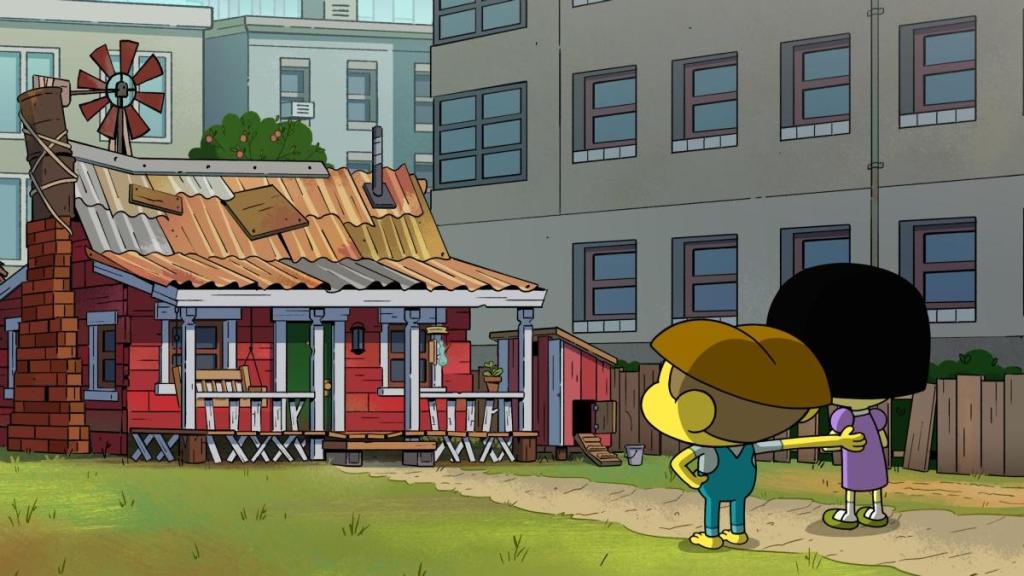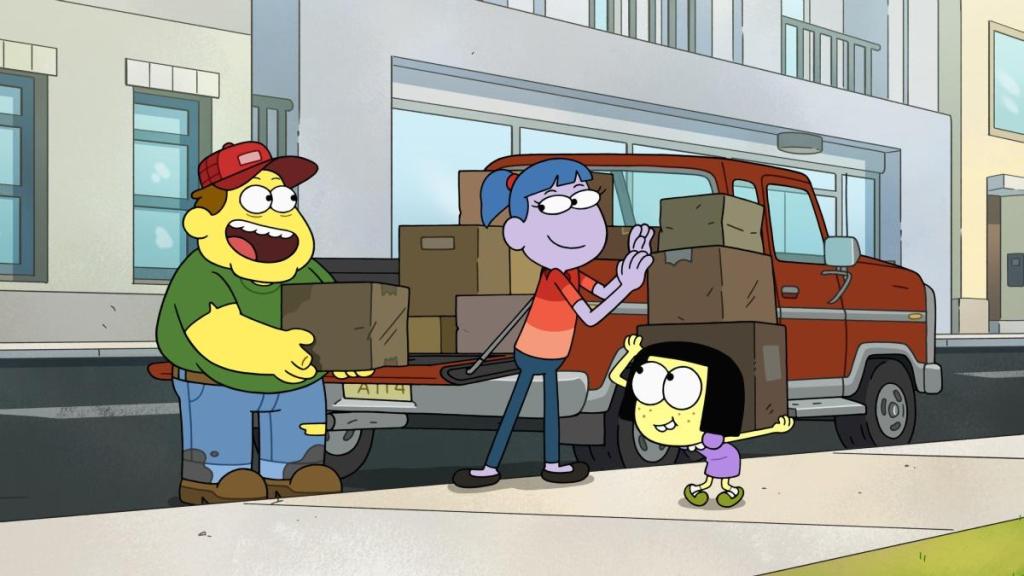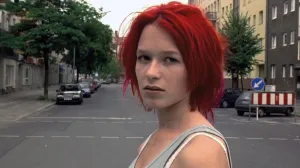Disney Channel’s Big City Greens is back following a Season 3 mid-season premiere that completely shifted the status quo for the Greens. If you missed “The Move,” the entire Green family — Nancy and, for reasons, Remy included — have moved back to the old family farm. This marks a serious departure from the fish-out-of-water stories that were being told with the group in Big City. And ComicBook.com had the opportunity to speak with creators Chris and Shane Houghton all about the change of scenery, what comes next, and somewhat inexplicably pyramid wells.
Videos by ComicBook.com
In general, if you are somehow not already aware, Big City Greens is in the middle of Season 3 and debuts new episodes on Disney Channel before eventually adding them to Disney+. The show was created by brothers Chris and Shane Houghton and stars the voices of Chris Houghton as Cricket Green, Artemis Pebdani as Gramma Alice, Marieve Herington as Cricket’s sister Tilly Green, Zeno Robinson as Cricket’s best friend Remy, Wendi McLendon-Covey as Cricket and Tilly’s mother Nancy, and Bob Joles as Cricket and Tilly’s father Bill Green. You can check out all of our previous coverage of the popular animated show right here.
Have you been keeping up with Big City Greens? Are you excited by the changes in Season 3? Let us know in the comments, or feel free to reach out and hit me up directly over on Twitter at @rollinbishop to talk about all things animation! And keep reading to check out the full interview with Chris and Shane Houghton!
The following interview has been lightly edited for length and clarity.
On Constantly Having to Outdo Themselves

ComicBook.com: It’s been a minute since we last spoke. So from me to you, congrats on the Season 4 renewal and the movie musical announcements earlier this year.
Shane Houghton: Thank you. Yeah, we’re very excited. Lots more Big City Greens coming up.
When last we spoke, you both talked about how each episode is basically another well you can never return to, and the pressure of that. Each episode has to answer the question of, “How do we top what we already did?” Have you found a solution to that, you feel? Or is it basically the same problem it always was?
SH: Well, you’ve seen “The Move.” So, I think you know in Season 3, we said, “Hey, let’s dig a whole new well.” That’s what we decided. “Let’s dig a whole new well to draw from.” So we really turned the premise of the show on its head and we took the country family out of the city, back to the country. That opened up a whole new avenue of storytelling for us. “What’s it like for the Greens to return to where they once originated from? What do the neighbors in this small town think of them now that they’ve been gone so long, have they become too ‘citified’? Do they miss the city? Do they miss their friends back in the city?” There’s a lot of story opportunities, and we have just been relishing all of the opportunities that moving into the country’s given us.
Chris Houghton: I think it also has revealed to us that idea generation is generating ideas. So maybe to break our own metaphor of the well, I think the more you think of ideas and challenge yourself to flex that creative muscle, the more ideas come to you and the more ideas you discover. So it’s almost the opposite of a well, maybe to go back on that – a well can dry up. I think the more you flex creative muscles, the more ideas come to you. The challenge never goes away. We certainly can’t repeat ourselves. We don’t want to repeat ourselves. But as we create more episodes, we are surprised to find that, wow, we continue to think of new ideas and new ideas spark more new ideas.
SH: I’m trying to think of what the opposite of a well is. Is it a mountain that goes up? Is it a geyser that shoots water into the air?
CH: It’s like working out, right? If you lift weights, it doesn’t make you weaker. It actually makes you stronger, which is kind of the opposite. It’s, I don’t know, an anti-fragile system, I think, is…
SH: Like building a pyramid, you’re laying the foundation. And the more blocks you lay, the bigger the pyramid gets.
CH: Eh, it’s like a pyramid well.
[mixed laughter from the group]
SH: Yeah, it’s a pyramid well!
Of course, the metaphor everyone knows and understands.
CH: But it’s very hard, to answer your question. It’s been hard.
On Starting From Scratch Again
Speaking of building up muscle though, part of that is destroying the old muscle. A change of scenery like this is always a big deal, but especially, I feel, for animation other than the characters themselves. It’s kind of starting from close to scratch. Was it particularly difficult having to go through that pipeline of, “All right, we’ve got whole new backgrounds, whole new areas to explore?”
CH: To make it even more challenging for ourselves – and no one chose this, but Season 3 was greenlit at the start of COVID and we were all working from home, and dealing with all the things that came with the pandemic. While also creatively challenging ourselves to, like you said, basically relaunch the show. I think both Shane and I had moments during it where we questioned ourselves, going, “Why did we bite off so much?” But like the Shel Silverstein poem, “How do you eat a whale, one bite at a time,” I’m glad we stuck to it. And the whole crew continued to challenge themselves, and we pushed through this massive…
SH: Undertaking.
CH: Yes.
SH: It really was like… Yeah, Chris is right. We perhaps bit off more than we can chew because in animation, so much of it – the reason animation in a TV pipeline works is there’s a lot of reuse. You visit same locations. You don’t have to draw those locations again because you’ve already drawn them. You reuse characters. But when you throw all that out the window, and you go to a new location, you meet new characters, it’s basically like watching a Season 1 of a show, which is simultaneously exciting and incredibly daunting. Because there’s just so much you have to produce.
So, kudos to our crew for really going on this adventure with us. I do think the thing that really helped everybody get through it and really dig in and produce some of the best work I think Big City Greens has made is because it’s such an exciting thing to happen in the show. We all really care about the characters and we really want this for them. So to see this, everybody was just really engaged in the stories, and that’s always really nice to see on a crew. So yeah, it’s been a wild challenge
CH: I think everyone was able to see what this relaunch could do for the series at large. And I think that helped serve as everyone’s North Star for pushing through those really tough times.
On Returning to the Family Farm Now

Right, and to be explicit, the whole thing is that the Green Family moves back to the family farm in this mid-season premiere, in “The Move.” You touched on this a bit, but can you speak more to… why now? What appeals to you about returning to this, what has not really been seen that much, but an iconic location for the show?
SH: You know, we’re in Season 3, we’re writing Season 3, and we knew we want – we’ve always had, the structure for our seasons, we like to do something big and shocking at our mid-season finale. So halfway through the season, we always like to introduce something big. In Season 1, their mom, Nancy returns to the family, a big shake up for the family dynamic there. In Season 2, Chip Whistler returns. We have our big “Chipocalypse Now” event. The whole community gets involved, so it was a big undertaking. And when we were talking about Season 3, we have always wanted to return the Greens from the city to the country.
Even back in Season 1, I remember we were writing episodes and there were executives who told us like, “Hey, can we go back to the country and see where they came from?” And we always really held fast to, “No, we can’t do that.” Outside of a couple of flashbacks here and there, we largely stayed away from the country because we knew we wanted to make it an event. We wanted to have a really big moment surrounding all of this.
Also, Chris, I don’t know if you feel the same way, but when Season 3 was greenlit, there was this thing at Disney for a long time where it’s like, shows only went three seasons. And we were kind of operating under like, “Well, if this is it for Big City Greens, let’s pull out all the stops. Let’s do something big and crazy. Let’s make it a potential series-ending event.” And then as we started writing the country episodes, we got greenlit for Season 4, which is fantastic. And the movie, that all started to happen simultaneously. Basically there’s an old writing thing that’s like, paint yourself into a corner, and then you figure out how to get out of it. And that’s exciting. I feel like that’s kind of where we got in Season 3, where it’s like, “Oh, this could have been the ending, but now we have this really exciting new challenge to how do we continue things.” And we found a really cool solution. And basically that’s where we’re going to continue into Season 4 and beyond. I’ve been rambling enough, Chris, what do you think?
CH: I agree. Well said! Well said. [laughs] I think there’s always a pressure when something becomes successful to not break the successful thing and just keep doing what you’re doing, but that’s boring on our end of things. Creatively, it’s boring. And I think the audience feels that, when things get stale. I think we’ve all seen long-running shows fall into certain pitfalls that cause them to become stale. We’ve also seen long-running shows that continue to reinvent themselves and stay fresh and exciting. And we certainly want to fall into the latter category. So I think what that means is, to use Shane’s metaphor, painting yourself into a corner, doing it before you think you’re ready. Changing things up before you think they need to be changed up. Telling that story you think you should tell two seasons from now – maybe telling it in this season. That tends to have always worked out for us. It creates a lot of creative challenges and it always makes us uncomfortable. Like, “Oh God, can we pull this off?” But if we’re asking ourselves, “Oh God, can we pull this off?” We’re probably doing the right thing.
SH: As stressful as that is, that’s what drives us. It’s the challenges…I think that’s why we’re doing a movie, and we’re still finishing Season 3, and we’re in full production on Season 4. And it is the craziest time to work on Big City Greens right now, but we’ve evolved. We’ve leveled up into this position because we’ve got comfortable with producing one season at a time or whatever. Now we’re just like, “Now let’s go whole hog and just go nuts with it.”
CH: I was thinking about that, because I keep saying recently, “Oh my God, we’re so busy.” I feel like we’re back in Season 1 again, where we’re new showrunners and we’re really, really busy.” But what I’m realizing is we’re just at another… We’re no longer comfortable. You get comfortable in certain positions when you get good at them or you have enough experience. And so we’re now stretched. We’re stretched and we’re feeling it, but that stretch causes growth. It’s all good. Good stuff.
On Whether the Greens Will Stay on the Farm for Now
Full spoilers, but at the end of “The Move,” the Greens are still on the family farm. It’s not uncommon, however, to see moves like this get reversed in serialized fiction. But it certainly seems like, based on your comments, looking towards an extended relocation, so to say.
SH: I think it’s safe to say now that when audience members are watching “The Move” I wanted them to feel like, “Is this a one off thing? They’re feeling uncomfortable. They don’t feel like they belong here. They’ll probably move back to the city at the end of this episode.” And then, they don’t. And that’s where we’re going to stay. That’s how we are continuing forward, and there’s a lot of lingering questions I feel like or where you’re like, “Well, how is that going to work? And what about their relationships with people in the city? And who are the new people they’re going to meet in the country?” And we talked at the beginning about all those different story opportunities and really that’s where we go with the season. There’s a lot of exciting things to explore.
On Remy Tagging Along and Zeno Robinson
Was Remy always set to tag along? Poor Vasquez, getting left behind.
SH: Yeah.
CH: We always wanted Remy to come along. The Greens, when they arrived in Big City, were fish out of water. And the longer they stayed in Big City, naturally they become slightly less fish out of water. And when they go back to the country… In a way maybe that fish-out-of-water stance is reignited because they’ve been citified, perhaps in certain ways? But certainly by bringing Remy along, who has never experienced country life, he can be kind of our fun audience surrogate. And there’s lots of fun to be had with Remy going on what he’s calling his “study-abroad trip” to the country.
SH: Remy can ask all the questions that the audience needs to know. The Greens are familiar. They’ve grown up in this house and they’ve lived there for a long time, but Remy can very clearly come in and be like, “What’s this and what’s happening?” And it’s very helpful to just turn the tables and make him the fish out of water.
It’s great how he gets that big moment near the end, and Zeno Robinson really knocks it out of the park with the material, I feel.
SH: Oh my God. Yes. First of all, Zeno has just grown into an incredible actor. We’ve been working with him for years now… Zeno was not working on the pilot. There was a different actor that we cast for Remy. The other actor is great and a super funny person, but something wasn’t working, something wasn’t clicking. And we had to recast. It was when we brought Zeno in that we’re like, “Oh, there’s the character. That feels right.” And I think Remy as a character has really bloomed and grown since then due to what Zeno brought to the character.
He’s grown into such a good actor and he’s had a couple of great speeches in the series before, but nothing like what he’s had in “The Move.” It’s a really emotional and empathetic and compassionate speech that always gets me teared up. I feel it in my heart, it gives my heart a little squeeze. And I’m just so impressed with that guy. And he’s doing great. So happy to have him on the cast.
CH: Yeah. He brings so many added layers to Remy and it’s cool to see that speech in “The Move,” because we’ve seen Cricket give speeches to Remy quite often, building him up, picking him up and telling him to go take on life. And it’s great to see those roles reversed and Remy be able to give back to Cricket and Tilly, and I think it also just shows Remy’s growth. And that’s something we’re certainly excited to explore further with all the characters, just seeing them grow the longer we spend time with them.
On the Constant Need to Fix Things
As a proud and harried homeowner, I have to say, I strongly identified with Bill’s need to fix things and getting overwhelmed. Was that drawn from some personal experience? It certainly felt true to life.
CH: [laughs] There is certainly a part in Big City Greens where you can tell crew members started to own their own condos or houses. All of a sudden there was more complaints about grout and certain woodworking projects. So yeah, I think any homeowner can agree that home ownership comes with stresses and a never-ending to-do list. And possibly an anxiety to want to accomplish that never-ending to-do list, which ultimately all we all know is impossible.
SH: That is really just a funny observation, but you’re spot on. I also feel like as a kid, our dad always had projects. The weekend rolls around, and he’s going to retile the bathroom or whatever he’s going to, or he’s going to caulk all the liners around the kitchen or whatever. And he always had those projects. I remember there’s a couple of times as a kid, I had to help out, and I was always just so bored with that. But now that I’m an adult and living in a house, I’m like, “Well, the weekend’s around, what kind of project am I going to get into today?” I think you just grow into it or something.
CH: We all start out as Crickets and we all grow into Bills. I remember being a kid and playing Sega Genesis with a buddy of mine and his dad, Terry, who was very much Bill-like. Terry ran in. He was like, “Boys, come here. I got to show you something.” And he took us into his little bathroom. He was remodeling and he wanted to show us the mistake he had just made so that when we grew up, we wouldn’t make the same mistake. And I can’t for the life of me tell you the lesson he was trying to impart on me because I was like, “Ah, why is this guy telling us this crap?” And it was something about… he cut something wrong, but I was like, “Man, I want to play Sega Genesis.”
SH: “Drink this in boys! If there’s one thing to remember, [mumbles incoherently].”
On What Comes Next for Big City Greens

Now obviously, without getting into spoiler territory, what can you say about what comes next this season?
SH: Well, we’ve touched on it, I think just briefly. What happens to the Greens’ relationship with grandma, who’s still living in the city? What happens with Gloria? Gloria has her cafe that she’s running back in the city and without the Greens there, what happens to her? Neighbors in the country, people who live in town, who are those folks and what are their relationships to the Greens? There’s a lot of fun things coming up. We also have some really wild episodes. There’s an episode called “Montage,” which is just a personal favorite of mine where it’s maybe a little bit more in the vein of “Cheap Show” or “Animation Abomination” where we break something and it’s a lot of fun.
CH: I would just add to your list, the kids connecting with old friends, or all the Greens connecting with old friends. There’s also the issue or the question I’ve seen posed online of, “Wait a second, Nancy’s moving back with them and she’s living with them. How does that work?” We address that. I would also say there’s interesting themes we play with about just returning to home. If anyone has moved away from home, they understand that there is an emotional journey that comes with moving away from home. But then there is a second emotional journey whenever you return to that home. And it brings up questions of, “What is home?” And I think ultimately the answer is everyone has to define that for themselves. And we certainly explore those themes with the Greens in a very fun way. Smalton is a great little place we’re developing and exploring. And it comes with this whole host of new characters that really, we just think people will love. So I don’t mean to make it sound too heavy. It’s very funny. And I’m excited for the rest of Season 3 to come out.
On Getting Animation Made in the Present Day
Happily and luckily, Big City Greens seems to continue doing quite well for itself. I’m sure I don’t have to tell you that the animation industry at current is in, shall we say, a rocky place. What advice, if any, would you give to someone trying to get an animated show made in this environment now?
CH: OK, here’s what I would not say. I think the easy response is one that we received from older people who saw the times in which they came up as being very different from the times we were coming up. It’s very easy to talk to the younger generation, and go, “It’s all over, good luck! The times we had are gone.” But the times always change. That is the constant, Bob Dylan once said it.
But really the industry, like all industries experiences good times and bad times – it’s cyclical, but the constant is people want good stories. People need good storytellers. People need good artwork, good writing, good designs. They need interesting things. The interesting things you have to say, people need to hear them. So stay positive, try to look for those opportunities and try not to get too wrapped up in the doom and gloom because there is so much doom and gloom, there always has been, and there always will be. But there’s light, there’s light, I say!
SH: That’s great. I have nothing to add. That is fantastic. Very well put Chris.
CH: If I can just add to that, Shane and I, we experienced many failures before Big City Greens. Big City Greens certainly is a product, I like to think, of our hard work and our crew’s hard work. It’s also a product of luck and timing, and things that are outside of our control. And there’s some quote about, “I find the harder I work, the luckier I get.” There’s something about persistence. So stick with it, and don’t focus on the things that are outside of your control. We can’t control what big studios are doing and investors and the streaming wars, but we can control our own stories and our own craft and focus on our own skills and just stay persistent with those things.








